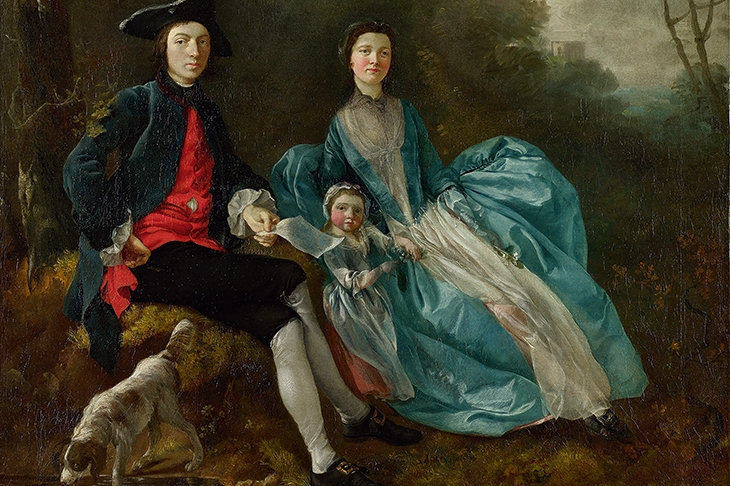When he knew that he was dying, Thomas Gainsborough selected an unfinished painting from some years before and set it on the easel in his studio. It was a portrait of his nephew, pupil and assistant Gainsborough Dupont, begun more than a decade earlier and set aside. This little work, which he seems to have intended as a sort of artistic last testament, also hangs at the end of the exhibition Gainsborough’s Family Album. What did he mean to tell us by making a small, intimate picture of a relative the conclusion to a career of more than 40 years? This marvellous and brilliantly conceived exhibition at the National Portrait Gallery supplies plenty of clues.
Firstly, it was doubtless significant that the picture on display after his death was of someone close. As the curator David Solkin explains in his catalogue essay, Gainsborough was precipitately socially mobile — upwards. The son of a bankrupt merchant-turned-postmaster from Sudbury, he died in a grand house — still standing — on the Mall, if not universally regarded as a gentleman, condemning and despising those who dared to treat him ‘in any other light’.
Like many British artists, he achieved this success through mass-production of commissioned portraits. But he found this work tedious. ‘If the people with their damnd Faces,’ he protested, ‘Would but leave me alone a little!’ Famously, he wrote that rather than ‘pick pockets in the portrait way’ he would have preferred to paint landscapes. Perhaps that was true, but as this exhibition makes clear, a number of his finest works were in fact portraits but uncommissioned ones, ordered by no one but himself.
Of none is that truer than of the pictures of his two daughters, Mary and Margaret, in their early years. It is hard to think of finer images of children in the entire history of art: tenderly observant, unsentimental, absolutely serious, loving (see p27). It is difficult to choose a favourite. The early one of the two girls chasing a butterfly, and the slightly later one, from after the family moved from Suffolk to Bath, of them playing with a cat, are both masterpieces.
If I had to choose, though, I would go for the double portrait of Mary the elder fastening an ornament in Margaret’s hair. This has been mutilated by someone who cut the two heads from a larger canvas then sewed them together. Even so — or conceivably as a result — it gives an extraordinary sense of the psychological and physical bond between two siblings.
Their father’s pictures of these sisters in later life are sadder, and less powerful. The grandest, a full-length double portrait from around 1774, shows them as fashionably dressed young women, about to embark, like a couple of characters in Jane Austen, on the complications of adulthood. It has a melancholy air, foreshadowing a bleak future. Mary married a musician, briefly and unhappily, and suffered for the rest of her life from some recurrent mental illness. Margaret devoted herself to looking after her.
Gainsborough’s pictures of his daughters are the most extraordinary in this show but others — of his wife, nephew, sisters and brothers — are almost as remarkable. And the closer the bond of the sitter with the painter, the better they tend to be. Thus ‘Sarah Dupont, the Artist’s Sister’, from c.1777–9, is a much stronger characterisation — of an intelligent, watchful, disappointed woman — than the slightly fuzzy pendant of her carpenter husband, John Dupont.
This is much what you would expect. In modern times, Lucian Freud and David Hockney have almost entirely avoided commissioned work, instead depicting friends, family and assistants. One guesses that Gainsborough would have done so if he could.
He would also, it seems likely, have ‘finished’ his works less than he was usually obliged to do. Constable, too, was bullied about ‘finish’ — that is, with a smoothly brushed, carefully detailed surface — by senior members of the Royal Academy. It was a depressing idée fixe in 18th- and 19th-century minds, with generally bad results. Even Joshua Reynolds was dubious about the ‘odd scratches and marks’ observable in the pictures of his friend and rival Gainsborough.
The catalogue considers various reasons why almost every one of these paintings of his inner circle was left ‘unfinished’. What is striking, as one walks around the galleries at the NPG, is that the pictures look better that way. The flickering rapid brush stokes were Gainsborough’s natural artistic handwriting. Like Van Gogh, he was pre-eminently a fast painter. One of his portraits of Gainsborough Dupont — the finest of all his works, in the opinion of his friend Philip Thicknesse — was done in an hour.
And the fact that such pictures look ‘unfinished’ positively helps them. In the picture he put on the easel in his painting room when he was dying, the ruff around Dupont’s neck is touched in with a dozen or so strokes, which might have taken him a minute or less. And it’s better that way, the fizzy energy of those loose squiggles of white pigment contrasting with and complementing the much more smooth and detailed face.
By leaving that picture as a posthumous manifesto, Gainsborough probably meant several things: that his pupil was his artistic heir, and that he himself was a follower of Van Dyck to whose work it gives an obvious nod (his last words were supposed to be: ‘We are all going to heaven, and Van Dyck is of the company’). But above all perhaps he wanted to indicate that this sort of painting was how he wanted to be remembered.






Comments